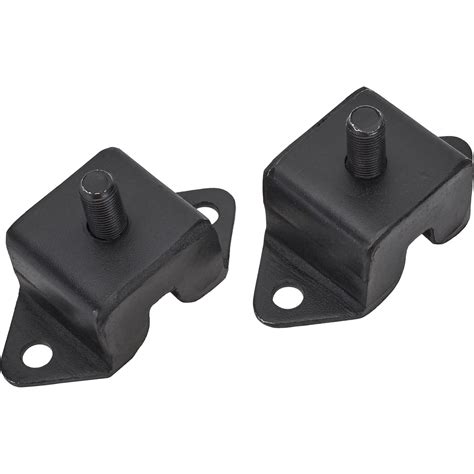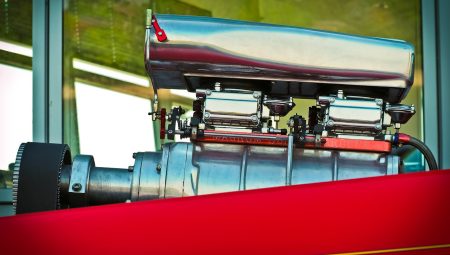Discover the purpose, signs of wear, and replacement tips for engine rubber mounts to enhance your vehicle’s performance and longevity.When it comes to maintaining a vehicle, one often overlooked component is the engine rubber mount. These seemingly simple parts play a crucial role in ensuring a smooth and stable ride. Engine rubber mounts are designed to absorb vibrations and support the weight of the engine, providing a buffer between the engine and the vehicle’s chassis. Over time, however, these mounts can wear down, leading to a host of issues that affect both performance and comfort. In this blog post, we’ll delve into the essential functions of engine rubber mounts, learn how to identify signs of wear, explore the process of replacement, and discuss how to choose the right mounts for your vehicle. Whether you’re a seasoned mechanic or a car enthusiast, understanding these components can greatly enhance your vehicle’s longevity and overall driving experience.
What are engine rubber mounts?
Engine rubber mounts, also known as engine mounts, are critical components in the automobile’s structural framework, designed primarily to secure the engine within the vehicle while simultaneously isolating vibrations and noise from the engine bay that could otherwise transfer to the passenger compartment. These mounts are generally constructed from a combination of rubber compounds and metal and are strategically positioned to absorb shocks and vibrations produced by the engine during its operation, ensuring that the engine remains stable while also allowing for slight movement that can occur as a result of natural engine operation and external driving conditions.
The purpose of utilizing engine rubber mounts goes beyond mere stability; they play an essential role in enhancing the overall driving experience by contributing to ride comfort, reducing engine noise, and ensuring that the engine’s alignment is consistent, which is vital for maintaining the integrity of various connected components, such as the transmission and exhaust system. A typical mount will consist of a vibration isolator made from high-quality rubber that can withstand significant stress, while a metal base provides the necessary strength to support the engine’s weight and resist the high torque generated during operation.
Furthermore, the functionality of engine rubber mounts can significantly influence the vehicle’s performance; by minimizing the impact of vibrations, they not only enhance comfort but also contribute to preserving the longevity of engine components and other systems within the vehicle, thereby preventing unwanted wear and tear. In summary, engine rubber mounts serve as a vital link between the engine and the chassis, ensuring that both can work harmoniously together while maintaining optimal performance and driver satisfaction.
The function of engine rubber mounts
Engine rubber mounts are crucial components in modern vehicles, playing a significant role in isolating vibrations generated by the engine from the rest of the vehicle, thereby ensuring a smoother and more comfortable ride for the passengers. These mounts serve not only as a means of securing the engine in place but also as a strategic buffer that absorbs and dampens the vibrations, which if left unchecked, can lead to excessive noise and discomfort, not to mention wear and tear on other vehicle components. By effectively managing the engine’s vibration and movement, rubber mounts contribute to prolonging the lifespan of various parts, including the engine itself, as well as enhancing overall vehicle performance.
In addition to vibration suppression, engine rubber mounts also provide essential spatial and structural support, maintaining the engine’s alignment during operation. The flexibility of the rubber material allows it to accommodate engine movements, such as those occurring during acceleration and deceleration, which could otherwise lead to stress fractures in the mounting points or misalignment of the engine components. This capability is particularly critical in high-performance environments where engines operate under varying loads and conditions, underscoring the importance of selecting high-quality motor mounts that can withstand these stresses over time.
Furthermore, the effectiveness of engine rubber mounts in fulfilling their functions is enhanced by their design, which often includes various shapes and sizes tailored to different vehicles and engine configurations. It’s also important to highlight that greater research and technology advancements have led to the development of innovative materials and designs for rubber mounts, resulting in improved durability, performance, and reduced noise levels. Therefore, understanding the essential functions provided by these components is crucial for vehicle owners and enthusiasts alike, as it emphasizes the importance of maintenance and when it may be necessary to evaluate the condition of the mounts to ensure optimal engine performance.
Signs of worn engine rubber mounts
The engine rubber mounts, which play a crucial role in securing the engine to the vehicle’s body while dampening vibrations, can experience wear and tear over time, leading to various symptoms that indicate their degradation, and understanding these signs of worn engine rubber mounts is essential for maintaining overall vehicle performance and safety.
One of the most notable signs that your engine rubber mounts might be worn is the presence of excessive vibration within the cabin, which can be quite disconcerting to the driver and passengers alike, and if you notice that the steering wheel shakes or that the vehicle shudders when idling, it is likely indicating that the mounts have become ineffective in isolating engine vibrations from the chassis.
In addition to noticeable vibrations, you may encounter unusual noises, such as clunking or banging sounds that seem to be coming from the engine compartment, and while these noises can stem from various sources, if they correspond with acceleration or deceleration, it strongly suggests that your engine rubber mounts may be losing their ability to absorb shocks, leading to metal-on-metal contact that is undesirable.
Moreover, a visual inspection of the mounts can reveal physical damage, such as cracks, splits, or separation of the rubber from the mounting bracket, as these degradation signs indicate a failing mount that will likely need to be replaced to prevent further complications like engine misalignment or increased strain on other related components.
In summary, if you find yourself grappling with odd vibrations, unsettling sounds, or visible deterioration of the rubber mounts, it is prudent to seek professional advice, as neglecting these signs of worn engine rubber mounts can lead to more significant issue
Replacing engine rubber mounts
Replacing engine rubber mounts is a crucial maintenance task for any vehicle owner who wants to ensure optimal performance and longevity of their automobile, as these components play a vital role in isolating engine vibrations and reducing noise within the cabin, while also helping to secure the engine in place, thereby preventing potential damage from excessive movement.
First and foremost, it is essential to understand that the process of replacing engine rubber mounts typically involves disconnecting the battery, lifting the vehicle using a jack, and safely supporting it with jack stands to ensure your safety during the replacement process, after which the old mounts can be unbolted and removed from their respective positions, allowing for the new mounts to be installed and properly secured.
After installing the new mounts, it is advisable to check the alignment of the engine once the vehicle is lowered back to the ground, ensuring that the engine rubber mounts are correctly positioned to prevent any misalignment issues that could lead to undue strain on the engine and other connected components, thereby bolstering the vehicle’s overall performance and enhancing driving comfort.
Choosing the right engine rubber mounts
When it comes to choosing the right engine rubber mounts, there are several factors that you need to consider to ensure that you are selecting a product that will provide optimal performance and longevity for your vehicle. One of the primary considerations is the specific make and model of your vehicle, as different vehicles may require different designs, materials, and levels of stiffness in their mounts to effectively absorb vibrations and support the engine.
In addition to compatibility with your vehicle, you should also take into account the driving conditions you typically encounter; for instance, if you frequently drive on rough or uneven surfaces, you might opt for heavier-duty mounts that can withstand more stress and provide better stability, thus preventing premature wear and tear. Furthermore, examining the material used in the construction of the engine mounts—such as natural rubber, silicone, or polyurethane—can greatly influence their effectiveness and durability.
Lastly, it is essential to consider brand reputation and warranties, as investing in high-quality, well-reviewed mounts from a reputable manufacturer can offer peace of mind and assurance of product reliability. While cost is always a consideration, remember that the cheapest option is not always the best, and sometimes a higher upfront investment in quality engine rubber mounts can lead to significant long-term savings by reducing the need for future replacements.
Frequently Asked Questions
What are engine rubber mounts?
Engine rubber mounts are components used to secure an engine to a vehicle’s chassis while absorbing vibrations and reducing noise.
Why are rubber mounts important for engines?
Rubber mounts are important because they help isolate engine vibrations from the vehicle, providing a smoother ride and improving overall comfort.
How often should engine rubber mounts be replaced?
Engine rubber mounts should be inspected regularly, and typically replaced every 5 to 7 years, or sooner if visible wear or damage is detected.
What are the signs that my engine mounts need replacement?
Signs that engine mounts may need replacement include excessive vibrations, engine movement when accelerating or braking, and unusual noises such as clunking sounds.
Can damaged engine rubber mounts affect vehicle performance?
Yes, damaged engine mounts can lead to poor vehicle performance, including decreased handling, increased noise, and potential damage to other engine components.
Are there different types of engine rubber mounts?
Yes, there are various types of engine rubber mounts, including hydraulic mounts, solid mounts, and polyurethane mounts, each with specific applications and benefits.
How can I choose the right engine rubber mounts for my vehicle?
To choose the right engine rubber mounts, consult your vehicle’s manufacturer specifications, consider your driving conditions, and discuss options with a qualified mechanic.





